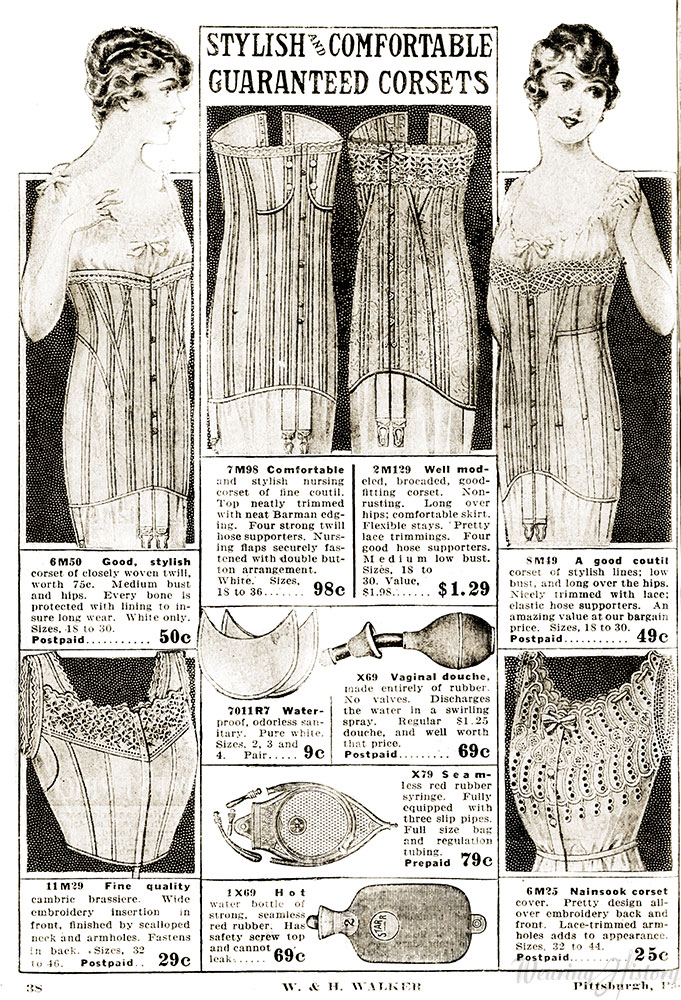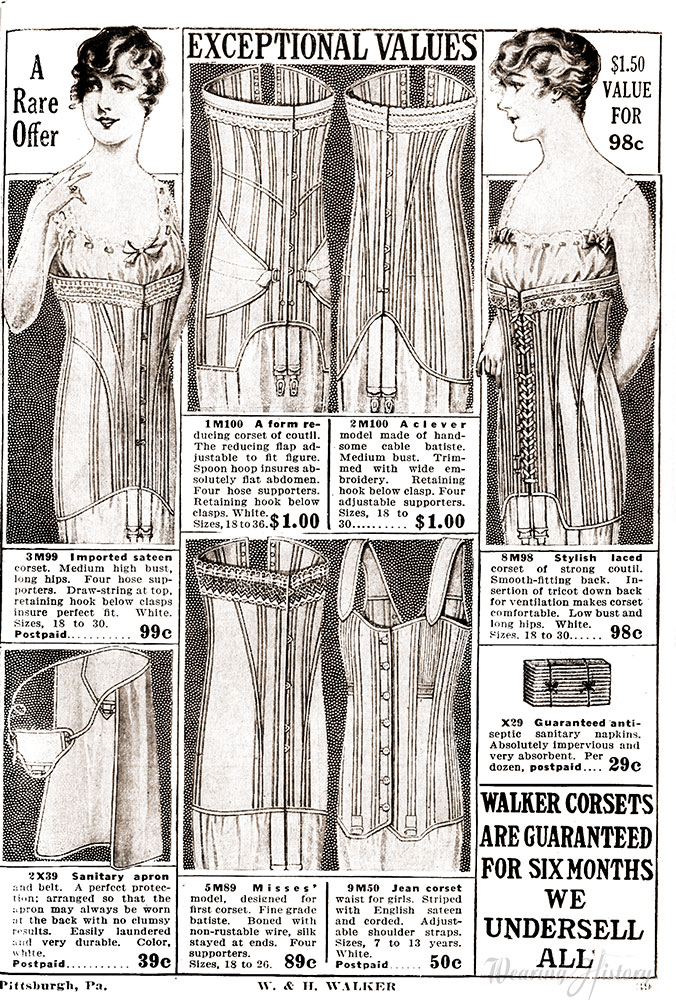In our 1910s Suit-A-Long group the question of corset height was brought up. Here are two pages of corsets from the 1916 W & H Walker catalog. This was the same year that the pattern was released, so is appropriate to the WWI era and the era of this suit.

 We see the difference in height of the top of the corset in these images. There is also a variety in length of the hip.
We see the difference in height of the top of the corset in these images. There is also a variety in length of the hip.
The size numbers would be for the corset size. It does not state if these are the actual corset measurements or the measure of the finished waist size. I am assuming they are the corset measure, as the “spring” allowed at back varied from person to person based on preference. The corset “spring” refers to the inches allowed at back for comfort- corsets would not be laced edge to edge, but allow, usually from 2″-4″, or even 6″ at the back when laced.
Sizes 18 to 30 have the most options. We see medium bust and hip (6M50), medium low bust and long hip (2M129), low bust and long hips (8M49), medium high bust and long hips (3M99).
There is one corset that is for comfort, with tricot for ventilation and front and back lacings (8M98), in the same sizes as above.
There is one corset for “Misses”, which would be for young ladies, and is designed as a “first corset”. 5M89 in sizes 18 to 26 waist.
There is one corset for girls, aged 7 to 13 years, which includes shoulder straps.
There is one nursing corset (7M98), which has nursing flaps at the bust and is available in larger waist sizes than the standard Misses corsets.
There is one corset for larger women, called a “form reducing” corset, which has a reducing flap at the sides, to help pull in the hips, and a spoon bust which “insures absolutely flat abdomen”.
One brassiere is shown on the page (11M29), which was available in sizes 32″ to 46″ bust. The brassiere has the appearance of a corset cover, but was of more substantial construction. These usually had flat felled seams, boning, or both, and fastened up the back. They did not have cups or breast support as we’re accustomed to today. In fact, most styles of dress did not require a separation of the bust, but rather, a smooth line. It’s a continuation of the “pouter pigeon” look of the S-Curve corset era, but with a slightly higher bust point. The bust may be restrained, but not as much as in the “flapper” era. In fact, brassieres would change very little between now and the late 1920s.
There are also various women’s needs that are on the page- mostly of the past “sanitary” variety. Included are women’s dress shields that are “waterproof”, and a “sanitary apron”, which would have the long skirt worn at the back so you wouldn’t have any accidents during that time of the month.
I, for one, am happy we’ve progressed… both in terms of undergarments and in terms of these icky “solutions”. How far we’ve come with both brassieres and sanitary products in one hundred years!

Evis
February 24, 2014 at 9:43 pm (10 years ago)The jean corset for girls is especially interesting to me; in Sweden those were called “reformliv”, that is reform bodice and first show up with the dress reform movement in the late 19th century. They were not intended just for girls and were worn by older women well into the 1940s. I’ve considered making one for this project actually, if I can find a pattern or drawing of the pieces.
littleblackcar
February 25, 2014 at 6:44 am (10 years ago)Napkins were EXPENSIVE! 29 cents for a dozen when you could get a whole corset for 49 cents?
Jennifer Rosbrugh
February 26, 2014 at 7:47 am (10 years ago)Ha! I thought the same thing. I really like seeing the sanitary apron – it’s so hard to find “period” discussions & items from the past as it’s not talked about. Love seeing it in this advert.
witness2fashion
March 2, 2014 at 11:46 pm (10 years ago)These corsets that stop at the low or mid-bust really require one of those mono-bosom brassieres or some other tight fitting undergarment. When I’ve done costume fittings for “cupless” corset periods, we always kept a supply of tank tops to wear under the corset & give some support, as these brassieres — or a chemise — would have done. If you have breasts bigger than a modern B cup, and you raise your arms, your breasts come up out of the corset and don’t go back inside it when you lower your arms — very awkward! Any garment that keeps large breasts from getting stuck on the outside of the corset is a big help. Hanging up the washing or putting up your long hair must have been difficult in 1916.
Lauren
March 4, 2014 at 3:15 pm (10 years ago)Great input! Thank you!